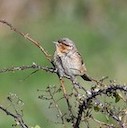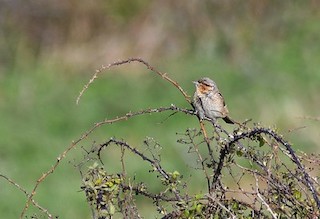 The Wryneck, a relative of the woodpeckers, is one of the rarer visitors to the Lizard in the autumn migrant season.
The Wryneck, a relative of the woodpeckers, is one of the rarer visitors to the Lizard in the autumn migrant season.
Photo: © Natural England/Dave Cornwell
Scientific name: Jynx torquilla
Other common names: Eurasian Wryneck, Snakebird, Cuckoo’s Mate
Conservation status: UK Birds of Conservation Concern, Red; UK Biodiversity Action Plan, Priority Species; IUCN Red List, Least Concern
What to look for:
- Colouring and appearance: Pale but heavily barred underparts, mottled brown-grey above, dark eye-stripe extending onto neck, and dark line along crown onto back. Long tail, with some bars. Like other woodpeckers, it has two toes pointing forwards and two backwards (this aids in climbing vertical tree trunks). Males and females are alike in appearance.
- Size: Length 16 to 18 cm, wingspan 26 cm.
- Where: A regular but far from abundant passage visitor to Britain in the autumn (and less frequently in spring). Found in scrub and open woodland, including old orchards, sometimes hopping on ground in search of its food of ants.
- Call: Repeated shrill notes (similar to the Lesser Spotted Woodpecker).
 The Wryneck is related to woodpeckers, but is often seen on the ground rather than up a tree. Its favourite (and predominant) food is ants, though it will also take other invertebrates, so you might see it hopping around searching for its prey. It has the large head and long probing tongue of its close relatives but is far less likely to be seen clinging to a vertical tree trunk, preferring instead to perch on horizontal branches, its plumage camouflaging it against the tree bark.
The Wryneck is related to woodpeckers, but is often seen on the ground rather than up a tree. Its favourite (and predominant) food is ants, though it will also take other invertebrates, so you might see it hopping around searching for its prey. It has the large head and long probing tongue of its close relatives but is far less likely to be seen clinging to a vertical tree trunk, preferring instead to perch on horizontal branches, its plumage camouflaging it against the tree bark.
They don’t make their own nest holes in trees, but re-use old woodpecker or other holes and will use nest-boxes. The female lays and then incubates a clutch of up to ten eggs, with both male and female feeding the young on ants and larvae.
The breeding range of the Wryneck is palaearctic, and encompasses most of Europe. In the autumn it departs for its wintering grounds south of the Sahara. It very seldom breeds in the UK, which is at the very edge of its European range, but we see a few passage visitors landing on our shores on their way south from Scandinavia in the autumn, and even less frequently in the spring. There was a time when we had more breeding pairs in the UK, though there were never many: there were probably between 200 and 400 pairs in the 1950s, but by the 1970s only a single pair was recorded, and they now breed here only sporadically.
Did you know…?
…The Eurasian Wryneck is the only European woodpecker that migrates over long distances.
…The Wryneck gets its curious name because of its ability to twist its head by almost a full 180°. When feeling threatened, especially on their nest, they twist their head in snake-like motions and hiss at the intruder. This twisting and hissing is presumably the reason for its local name of Snakebird, and also led to the bird being invoked in witchcraft to put a spell on someone.
More information and references:
Svensson, L., Mullarney, K., Zetterstrom, D.,1986. Collins Bird Guide, second edition (translated by Christie, D., Svensson, L.). HarperCollins, London.
Published: September 2014
Author: Amanda Scott
Photos: © Natural England/Dave Cornwell
